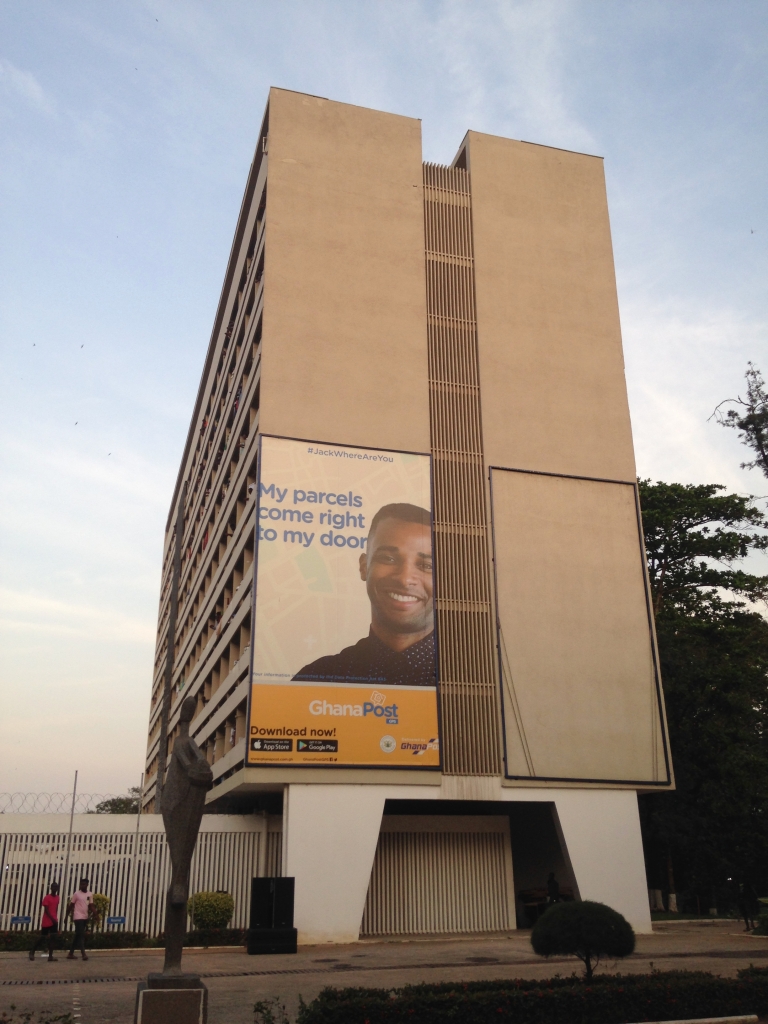The aim of this project is to investigate if, and to what extent do ‘tropical modernist’ structures modify or mitigate climatic conditions to create more ‘comfortable’ interiors.
Most of these structures were designed to be passively cooled and as such have a permeable façade composed of concrete screens or louvres to facilitate cross ventilation air-flow, and to create shade. A good example is the Children’s Library in Accra, designed by Nickson and Borys in 1957.
Mainly built during the 1930s-70s, these buildings are now at an age when they require refurbishment and rehabilitation – although this is mainly superficial and does not involve structural correction. There are various options pursued, many involving the installation of air-conditioning units. For the AC to be effective it ideally requires a sealed interior volume, rendering the existing permeable façade unsuitable.


One solution being increasingly used in Ghana is to externally clad the façades with a glazed screen, as seen on the Standard Chartered Bank on Accra’s High Street.
The glazing cuts out street and traffic noise and reduces dust infiltration, as well as enabling the interior to be mechanically cooled. But in terms of energy usage (consumption of AC and in the fabrication of the glazed units) it is far from ideal. Furthermore, there is the financial cost of cooling what is now effectively a greenhouse in a hot and humid climate. Architecturally the building has also been dramatically altered. It is now a bland non-descript block, and lacks the patterns, shading effects, and references to the floors behind the façade. I’m not suggesting that this example is a prestigious heritage monument, but rather using it to illustrate what is becoming an increasingly common approach to refurbishment. Fortunately, in this case glazing can be easily removed and the older structure has been preserved inside.
Our project has several objectives, including to:
- Recognise and promote the significance of these 20thC modernist structures.
- Determine if the passive cooling approach does create sufficiently comfortable interiors.
- Investigate what conditions are comfortable for the occupants of these buildings.
- Investigate alternatives to AC that provide low cost and low energy comfortable interiors without detrimentally impacting upon the architectural quality.
To test both inland and coastal conditions we’ve selected a case study at KNUST in Kumasi, and another at the University of Ghana, Accra. Both buildings are university libraries, and as such have a large number of daily visitors that we can consult. The library at KNUST was designed as a louvred screen wall, fully adjustable from the interior, and also has a later brutalist extension with a twin façade arrangement and partially air-conditioned interior.

At Accra, the Balme Library takes a more colonial/traditional approach with a series of courtyards, loggias and high ceilings. Some of the rooms have been retro-fitted with air-conditioning, whilst at the same time naturally ventilated. Both libraries are large institutional buildings and have the potential to consume large amounts of energy should they be refurbished with full AC and cooled to ASHRAE recommendations. Furthermore, it is important for the health and education of the staff and students that these buildings are comfortable places to spend time in, and to study.

In each building we’ve installed a number of Hobo data-loggers that record the temperature and humidity at regular intervals. Whilst this data allows us to determine whether the internal temperature/humidity is different to the external condition, it does not tell us if the conditions are comfortable to the inhabitants. To establish this, we’ve consulted the library users and staff to enquire how comfortable they feel in the various library spaces. The respondents also recorded their attire, age, sex, and how long they have been in the library prior to completing the survey. Over 250 people completed the survey at KNUST in January 2020. We will repeat this in the ‘rainy season’, and conduct similar surveys at Accra. When we’ve gathered this data we can correlate the data-logger findings with those of the user surveys. We’re also constructing 3d computer models of the buildings to test various refurbishment scenarios and cooling options.
Our partners in this project are Dr. Haniyeh Mohammadpourkarbasi at University of Liverpool; Dr. Irene Appeaning-Addo and Dr. Dan Nukpezah from University of Ghana; and Prof. Rexford Assasie-Oppong at KNUST. We’re also indebted to the library staff and students at each institution. Funding has been generously provided by the University of Liverpool ODA Seed Fund 2019-2020.
Updates to follow when we have more data and findings to report.

